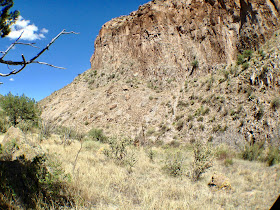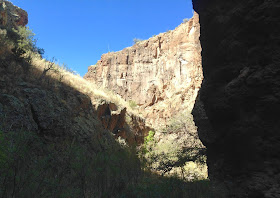Last year, this same week, I visited the amazing box of East Red Canyon. I had wanted to continue the hike into the box/slot of Deep Canyon, one of two major tributaries on its south side. The heat, and worries about approaching thunderstorms had me leave it to another day.
Another day arrived, with a dry forecast, and so I was off. I parked much closer in this time, right at the mouth of East Red's box. I had given thought to driving up on the mesa in between Deep Canyon and Cold Springs Canyon on FR 984, but when I looked at the thick gravel of a roadbed barely incised into the side of the steep hill, I changed my mind. If I had done it, I would have cut out walking through East Red and then very wide lower end of Deep Canyon, by scrambling down to the mouth of the box of Deep from the mesa.
Going on foot seemed preferable to white knuckling up the hill on the road plus whatever driving mysteries that awaited on top. The walking was easy on the level gravel of East Red and soon I was turning up Deep Canyon walking through its narrow mouth into a wide valley with grasses, piñons and junipers.


It was plenty warm already even though it hadn't reached 10:00 yet. The hike though, was more pleasant that I would have imagined. Bunnies darted out of the shrubs as I cruised on the cow paths. Soon the gentle hills on either side stopped and the cliffs of volcanic rock, low at first, began. They got higher, not quite as high or sheer as East Red, but almost. The canyon bottom was much narrower than East Red as well. While East Red had hackberry, walnut and boxelder pressed hard against the cliffs with the wide gravel channel in between, Deep Canyon was more like a low elevation forest environment. Oaks, straight growing junipers, piñons, plus New Mexico locust, cholla and grasses along with very occasional small boxelder and walnut made the going a bit thick at times even with the wildlife paths to follow.



There was even one very photogenic ponderosa pine and few of its offspring in the shadow of the tallest pock marked cliffs where the temperatures are cool enough for them to survive.

Cackles of canyon wrens echoed off the walls of rock, but with the continuing dry conditions, only slightly relieved in the last few weeks, the place was remarkably devoid of the sounds of wildlife. After getting to its narrowest passage that cuts through a lower shelf of bedrock, the box canyon opens up with the craggy rust colored cliffs giving way to the sun baked grass and cholla covered slopes again. As the temperature was closing in on 90 degrees, and my shade was now gone, I turned around.


On the way back, I looked for likely looking alcoves that ancient peoples could've utilized but found no sherds or lithics as I had last year in East Red. I lunched around noon in the shade of the cliffs and junipers near the entrance to the box. I climbed up on bench on the east side to walk most of the way back to the confluence. I gave some thought to climbing up to the mesa to walk along the south side of East Red on the mesa, but it was just plain old hot at this point, and I opted for shade of the canyons.


This is an awesome area for exploring. If it was close to Santa Fe or Albuquerque it would be packed with people every weekend. A really great loop hike would be to go up East Red, then Deep Canyon and then come back down the box of Cold Spring Canyon. Unfortunately, much of the box of Cold Spring is private property. Still, one could go up on the mesa and use it for the return leg.



















No comments:
Post a Comment